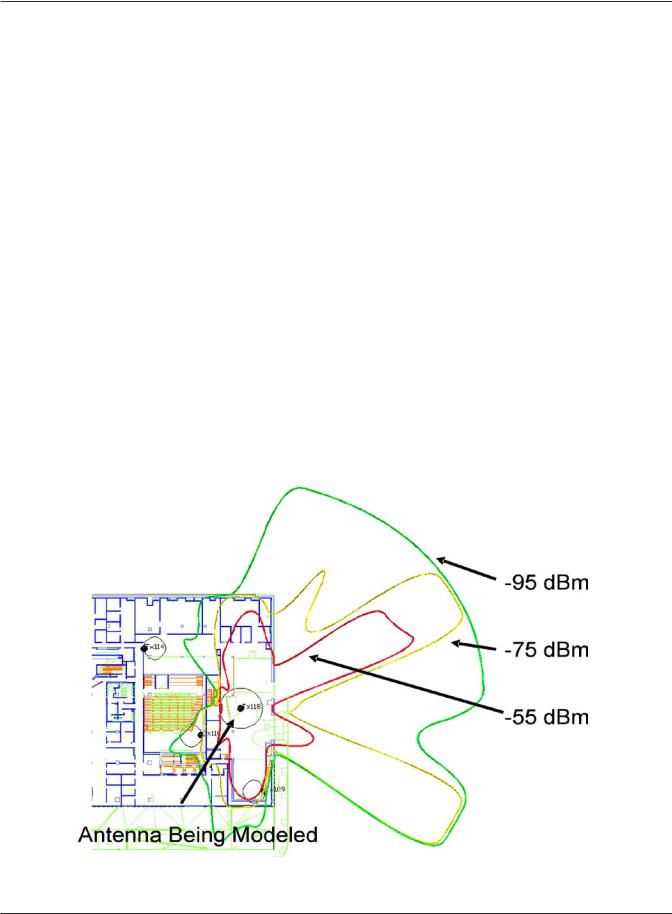
- •Math and Physics for the 802.11 Wireless LAN Engineer
- •About the Author
- •Section 1: Introduction
- •Are You the Professor, or the Chauffeur?
- •Purpose and Perspective
- •Apprehensive Attitudes Resulting from Lack of Knowledge
- •What You’ll Learn in this Paper
- •A Note to the Reader Familiar with the Subject
- •Section 2: Electricity and Electromagnetic Fields
- •Electrical Force
- •Resistance and Reactance
- •Power Measurement
- •Watts, Milliwatts, Decibels, and dBm Units of Measurement
- •Magnetic Fields
- •Figure 2.1 The Magnetic Field Surrounding a Current Carrying Conductor
- •Zeno’s Paradoxes
- •Bardwell’s ERP Paradox
- •Section 3: The Electromagnetic Spectrum
- •Figure 3.1 The Electromagnetic Spectrum
- •The Shape of the Electromagnetic Field
- •Figure 3.2 The Spherical Radiation Pattern of a Theoretical Isotropic Radiator
- •Figure 3.3 The Doughnut-Shape of the Electromagnetic Radiation Pattern
- •Particles and Waves
- •Figure 3.4 A Beam of Light Reflecting From the Surface of a Mirror
- •Figure 3.5 A Beam of Light Manifesting Fresnel Diffraction
- •Figure 3.6 A 15-mile Span Using 6 Antennae and 2 Repeaters
- •Figure 3.7 Monthly Sunspot Activity Since 1950
- •The Electromotive Force
- •Scalar and Vector Measurement Metrics
- •Figure 3.8 Hiking in the Las Trampas Wildlife Refuge
- •Measuring the Characteristics of the Electromagnetic Field
- •Differentiation of Functions with One Independent Variable
- •Figure 3.9 Position Versus Time and the Rate of Change
- •Figure 3.10 The Notation for Differentiation
- •Differentiation of Functions With More Than One Independent Variable
- •Magnetic Flux Density (B) and the Vector Potential (A)
- •Figure 3.11 Partial Differentiation to Compute the Components of B
- •Figure 3.12 Basic Maxwell Wave Equations in Vector Form
- •Section 4: Electromagnetic Field Propagation
- •Time Symmetry and the Reciprocity Theorem
- •Practical Considerations Related to Antenna Reciprocity
- •Figure 4.1 Correct and Incorrect 802.11 Access Point Antenna Orientation
- •Transmitters and Receivers with Different Power Levels
- •Propagation of Electromagnetic Waves in Space
- •Figure 4.2 The Radiating Elements of a Dipole Antenna
- •Figure 4.3 Wavefront Formation with a Dipole Radiator
- •Figure 4.4 The Electromagnetic Field Surrounding a Dipole Antenna
- •Coupling and Re-radiation
- •Representing the Direction of Field Propagation
- •The Transverse Wavefront
- •Figure 4.5 Surface Area Defined On the Spherical Wavefront
- •Figure 4.6 An 802.11 NIC Encounters a Flat, Planar Wavefront
- •The Electromagnetic Field Pattern
- •Polar Coordinate Graphs of Antennae Field Strength
- •Figure 4.7 The Elevation Cut View of Antennae in a Warehouse
- •Figure 4.8 The Azimuth Cut View of a Directional Antenna
- •Figure 4.9 Polar Coordinate Graphs for an Omni-Directional Antenna
- •Figure 4.10 Vertical and Horizontal Cuts of an Apple
- •Figure 4.11 Close-up View of the Elevation Cut Polar Coordinate Graph
- •Figure 4.12 The Omni-Directional Elevation Cut Seen in the Warehouse
- •Figure 4.13 Polar Coordinate Graphs for a Directional Antenna
- •Figure 4.14 The Elevation Cut Rotated to the Left
- •Figure 4.15 The Directional Antenna’s Elevation Cut Seen in the Warehouse
- •The “E” Graph and the “H” Graph
- •Half-Power Beam Width
- •Figure 4.16 Antenna Field Pattern and Half Power Beam Width Measurement
- •Half-Power Beamwidth on a Polar Coordinate Graph
- •Figure 4.17 Identifying Half-Power Beamwidth (HPBW) Points
- •Figure 4.18 Horizontal and Vertical Beamwidth for a Directional Antenna
- •Figure 4.19 The Field Pattern for a Full Wavelength Dipole Antenna
- •Figure 4.20 The Field Pattern for a Half-Wavelength Dipole Antenna
- •Use of the Unit Vector
- •802.11 Site Considerations Related to Beamwidth
- •A Challenging Beamwidth Question
- •Figure 4.21 The Client and the Access Point Are Within Each Other’s HPBW Zone
- •Signal Strength and Reduced Data Rate
- •Figure 4.22 User #1 Is Outside the Beamwidth Angle of the Access Point
- •Physical Measurements Associated With the Polar Coordinate Graph
- •Figure 4.23 The Polar Elevation Cut as it Relates to a Real-World Situation
- •RF Modeling and Simulation
- •Figure 4.24 Results of an RF Simulation
- •Section 5: Electromagnetic Field Energy
- •The Particle Nature of the Electromagnetic Field
- •Field Power and the Inverse Square Law
- •Figure 5.1 Determining the Surface Area of a Sphere
- •Electric Field Strength Produced By An Individual Charge
- •Figure 5.2 The Strength of the Electric Field for an Individual Charge
- •Time Delay and the Retarded Wave
- •Figure 5.2 (repeated) The Strength of the Electric Field for an Individual Charge
- •The Derivative of the Energy With Respect To Time
- •Effective Radiated Power
- •The Near Field and the Far Field
- •Figure 5.3 The Far Field Transformation of the Field Strength
- •Signal Acquisition from the Spherical Wavefront
- •Figure 5.4 The Spherical Presentation of the Wavefront
- •Figure 5.5 An Impossible Antenna of Unreasonable Length
- •The Boundary Between the Near Field and the Far Field
- •Figure 5.6 Out of Phase Signals Meeting a Vertical Antenna
- •Figure 5.7 A Close View of the Out of Phase Waves
- •Characteristics of the Far Field
- •Considerations Concerning Near Field Interaction
- •The Reactive Near Field and the Radiating Near Field
- •Antenna Gain and Directivity
- •Figure 5.8 A Spherical Versus a Toroidal Radiation Pattern
- •Phased Array Design Concepts
- •Figure 5.9 Top-View of Canceling Fields Parallel to the Two Radiators
- •Figure 5.10 Top-View of Augmenting Fields Perpendicular to the Two Radiators
- •Figure 5.11 A Multiple Element Phased Array Field Pattern
- •Parasitic Element Design Concepts
- •Figure 5.12 The Yagi-Uda Antenna
- •Antenna Beamwidth and the Law of Reciprocity
- •Figure 5.13 The Depiction of an Antenna’s Beamwidth
- •Section 6: The Huygens-Fresnel Principle
- •Figure 6.1 A Spherical Wavefront from an Isotropic Radiator
- •Figure 6.2 Each New Point Source Generates a Wavelet
- •Applying the Huygens-Fresnel Principle in the 802.11 Environment
- •Figure 6.3 An Obstruction Causes the Wavefront to Bend
- •Diffraction of the Expanding Wavefront
- •How Interference Relates To Diffraction
- •Figure 6.4 Wavelets Combining Out of Phase at the Receiver
- •Figure 6.5 The Critical Angle at Which the Wave is 180O Out of Phase
- •Figure 6.6 The Effect of an Obstruction on the Received Wavelets
- •Figure 6.7 The Receiver’s Location Determines the Obstructions Affect
- •Fresnel Zones
- •Figure 6.8 The Oval Volume of a Fresnel Zone
- •Figure 6.9 Multiple Fresnel Zones Built Up Around the Central Axis
- •Fresnel Zones are not Related to Antenna Gain or Directivity
- •Calculating the Radius of the Fresnel Zones
- •Obstructions in the First Fresnel Zone
- •Figure 6.10 Interior Obstructions in the First Fresnel Zone
- •Practical Examples of the Fresnel Zone Calculation
- •The Fresnel Construction
- •Figure 6.11 The Pythagorean Construction of the First Fresnel Zone
- •Figure 6.12 Two Triangles Are Constructed Between Transmitter and Receiver
- •Dealing with an Unfriendly Equation
- •One More Equation
- •The Erroneous Constant of Proportionality
- •Figure 6.13 The Typical Presentations of the Fresnel Zone Equations
- •Concluding Thoughts
- •Appendix A
- •The Solution To Zeno’s and Bardwell’s Paradoxes
- •Appendix B
- •Trigonometric Relationships: Tangent, Sine, and Cosine
- •Figure B.1: Trigonometric Relationships In Right Triangles
- •Figure B.2: The Basic Trigonometric Relationships in a Right Triangle
- •Appendix C
- •Representational Systems for Vector Description
- •Figure C.1 Vectors Represented Using Cylindrical Coordinates
- •Figure C.2 The Spherical Coordinate System
- •Appendix D
- •Electromagnetic Forces at the Quantum Level
- •Appendix E
- •Enhanced Bibliography

Thereʼs another physical reality to take into consideration in this situation that makes a real-world implementation of 802.11 perhaps not as immediately susceptible to poor performance in some locations as might be calculated. Weʼll discuss in detail later the fact that the RF wavefront doesnʼt conform to the free-space 3-dimensional shape and power distribution that would be calculated in theoretical terms. The environment is distorting the actual wavefront so that itʼs probable that the user will be in a zone that actually has more power than that contributed solely by the theoretical field pattern. Itʼs also possible that the user could have less power available to them than calculated. Reflection, refraction, and diffraction of the RF signal is taking place due to the various metal objects, walls, furniture, and other objects in the environment. Weʼll discuss in detail how metal objects influence wave propagation. A typical 802.11 office environment may contain metal file cabinets, metal window blinds, and perhaps metal shelving units. Even the metal in desk or floor lamps influences electromagnetic wave propagation, and, of course, donʼt forget all of the metal in the computers in the environment too. Nonetheless, using the polar coordinate signal strength graph is a fundamental starting point in antenna positioning and RF coverage planning.
RF Modeling and Simulation
Advanced computer modeling and simulation software is available that applies the formulas associated with electromagnetic wave propagation to the floor plan of a building or to an outdoor area. Using simulation tools allows prediction of antenna coverage to within +/- 2 dB, a very accurate measurement!
Any time an 802.11 network is being designed it can be very valuable to perform a predictive RF simulation of the space and see what the electromagnetic wave propagation patterns would really look like.
Figure 4.24 Results of an RF Simulation
Math and Physics for the 802.11 Wireless LAN Engineer |
49 |
Copyright 2003 - Joseph Bardwell

The wavefront coming from the antenna being modeled is shown at the -55, -75, and -95 dBm propagation boundaries. You can see how the signal extends out from the exterior of the building with the strong -55 and -75 dBm lobes passing through the glass doors and windows. To the left of the antenna there is a wide metal stairway that is effectively blocking the signal.
Unlike an antennaʼs polar coordinate graph, the pattern drawn by modeling and simulation software actually represents an RF propagation boundary and shows us what the field would really look like if we could see it with our eyes.
Math and Physics for the 802.11 Wireless LAN Engineer |
50 |
Copyright 2003 - Joseph Bardwell
